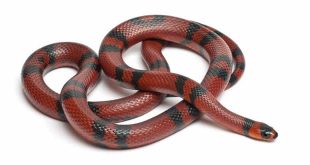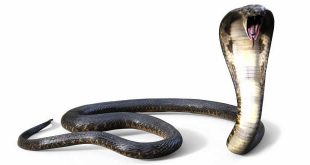Kingdom: Animalia Family: Colubridae Order: Squamata Class: Reptilia Milk Snake — This is a species of king snake. There are around 25 subspecies among the milk snakes, including the scarlet kingsnake (Lampropeltis triangulum elapsoides). The subspecies have strikingly different appearance, and many of them have their own common names. They are found from Canada to Ecuador,and will grow 24 to …
Read More »Cobra: Venomous Snake – Reptiles Encyclopedia
Kingdom: Animalia Family: Elapidae Order: Squamata Class: Reptilia Cobra Snake — A cobra is a venomous snake of family Elapidae, of several genera, but particularly Naja. (Non-cobra elapidae include the taipans, brown snakes, tiger snakes, fierce snakes, coral snakes, mambas, and sea snakes.) Cobras generally inhabit tropical and desert regions of Asia and Africa. The most common cobra is the …
Read More »Sea Turtle
Sea Turtle — Sea turtles (Superfamily Chelonioidea) are turtles found in all the world’s oceans except the Arctic Ocean .There are seven living species of sea turtles: flatback, green, hawksbill, Kemp’s Ridley, leatherback, loggerhead and olive ridley. The East Pacific subpopulation of the green turtle has been classified as a separate species in the past as the black turtle. However, …
Read More »Sidewinder
Sidewinder — Crotalus (Sidewinder) cerastes is a venomous pitviper species found in the desert regions of the southwestern United States and northwestern Mexico. Three subspecies are currently recognized, including the typical form described here. A small species, with adult specimens measuring between 43 cm and 76 cm in length. According to Campbell and Lamar (2004), most adults are 50-80 cm …
Read More »Skink
Skink — Skinks are the most diverse group of lizards. They make up the family Scincidae which shares the superfamily or infraorder Scincomorpha with several other lizard families, including Lacertidae (the “true” or wall lizards). Scincidae is the largest of the lizard families with about 1,200 species. Skinks look roughly like true lizards, but most species have no pronounced neck …
Read More »Sea Snake
Sea Snake — Sea snakes, or “seasnakes”, are venomous elapid snakes which inhabit marine environments for most or all of their lives. Though they evolved from terrestrial ancestors, and some such as Laticauda sp. retain ancestral characteristics which allow limited movement on land, most are extensively adapted to a fully aquatic life and are unable to even move on land. …
Read More »Sawback Turtle
Sawback Turtle — Graptemys is a genus of turtles known commonly as map turtles or sometimes sawback turtles. They are aquatic, freshwater basking turtles that are found throughout the eastern half United States and into southern Canada. They superficially resemble many other species of aquatic turtle, including sliders (genus Trachemys) and cooters (genus Pseudemys), but are distinguished by a keel …
Read More »Rattlesnake
Rattlesnake — Rattlesnakes are a group of venomous snakes, genera Crotalus and Sistrurus. They belong to the class of venomous snakes known commonly as pit vipers. There are approximately fifty species of rattlesnake, with numerous subspecies. They receive their name for the rattle located at the tip of their tails. The rattle is used as a warning device when threatened. …
Read More »Ridley Turtle
Ridley Turtle — Two species of sea turtles in the family Cheloniidae are called ridley turtles. Both may attain a length of about 700 mm (27.5 in) and commonly weigh between 30 and 36 kg (65 and 80 lb). The Indo-Pacific ridley, Lepidochelys olivacea, occurs in parts of the Indian, the Pacific, and possibly the Atlantic oceans. It is almost …
Read More »Mud Turtle
Mud Turtle — Mud turtle is the common name given to two genera of aquatic turtles: Kinosternon, mud turtles found in North and South America, and Pelusios, mud turtles found in Africa. Some species are kept as pets. Mud turtles are known for their dull shell colors and relation to the smelly musk turtles. African and American mud turtles are …
Read More » Kids Portal For Parents India Kids Network
Kids Portal For Parents India Kids Network

